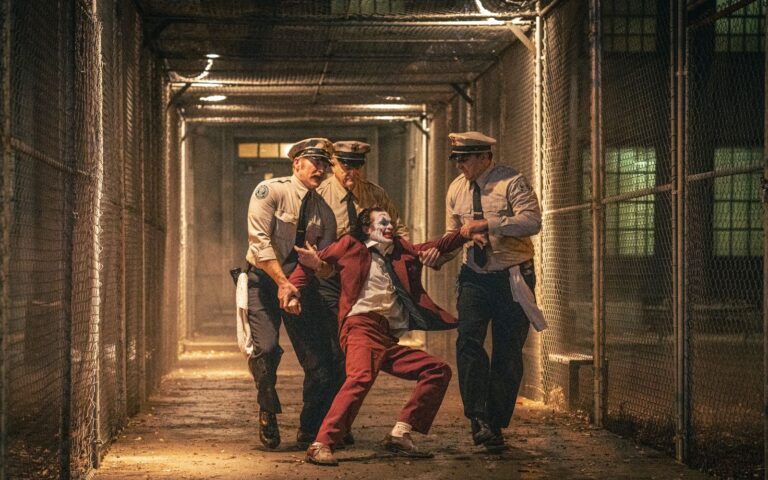By Adriel Smiley
Ian Mark Kimanje’s powerful documentary traces Carnival’s roots from slavery and survival to global celebration.

Todd Phillips follows up his 2019 box office smash, Joker, by taking aim at its divisive cultural legacy. Instead of doubling down on its much-derided social commentary, Joker: Folie à Deux is an inversion, unfolding as a middle finger to fans who view protagonist Arthur Fleck (Joaquin Phoenix) as a relevant and urgent symbol of society’s ills. If that wasn’t enough, the sequel’s transition into the musical genre is enough to alienate the most diehard. It’s a seemingly bold enough approach that most detractors of the original – and the universe of films that it draws from – should be on board with it. But Joker: Folie à Deux is so drab, listless, and superficial that it only serves to unite both sides in shared distaste of Phillips’ take on the iconic villain.
Joker: Folie à Deux understands its unique place within the comic book canon, but none of its grand stylistic ambitions save it from sticking out like a sore thumb. From the Looney Tunes-inspired opening (vibrantly animated by Sylvain Chomet) to each musical number to its French titling, almost every component of Philips’ sequel feels superfluous and tangential—all incongruous parts of a film that inherently struggles to justify its existence.
The story co-penned by Phillips and Scott Silver is set two years after the first film, which concluded with Arthur gunning down a talk show host (played by Robert De Niro) on live television, under his Joker persona. Now, Arthur is locked in Arkham Asylum and faces the death penalty. While his lawyer, Maryanne Stewart (Catherine Keener), prepares a multiple personality disorder defence, Arthur finds the love of his life in Harleen “Lee” Quinzel (Lady Gaga), a fellow patient. She obsesses over him—or rather, his infamous alter ego—pulling him into a fantasy world that doubles as a twisted golden age musical, all while his incendiary trial unfolds.
Each musical number and courtroom confession confronts whether “The Joker” is a revolutionary response to the system or simply the coping mechanism of a mentally ill and abused man. While Phillips’ film ultimately chooses a side, it does so with a sense of self-satisfaction and indulgence that barely scratches the surface. In the words of Macbeth, another tragic figure, Joker: Folie à Deux is full of sound and fury, signifying nothing.
The film is rife with moments that graze interesting ideas, but lack the finesse and gumption to weave them together in any meaningful or absorbing way. Instead, it’s all part of a feigned exercise in cinematic trolling, designed to upend the expectations of ardent supporters of the first entry while lacking the thematic meat to entice disparagers. In the contested distinction between art and artifice, Joker: Folie à Deux firmly lands in the latter.

Phillips partly trades the first film’s pastiche of Martin Scorsese for one of old-Hollywood musical director Vincente Minnelli in Joker: Folie à Deux, featuring clips and lifeless renditions of “That’s Entertainment” from his classic The Band Wagon (1953). Much of the sequel is steeped in reference to the grand MGM musicals of yore, but like its predecessor, it fails to rise above an imitation of their style, form, and content. While undeniably framed and designed with skill — including a stunning variety show sequence where Joker and Lee transform into a twisted Sonny and Cher — it all reeks of a film that desperately wants to shed its comic book trappings to appear edgier and provocative. For every impeccably staged emotion or character arc, there are pits of unearned ones. Unlike its influences, it fails to immerse and implicate us in the violence and grave choices of its characters.
That immersion is an effect that’s especially difficult to achieve when the two leads lack chemistry. Gaga is woefully underutilized, rendered the amalgamation of stares and gestures that amount to little more than a mental crutch for Arthur. She’s never allowed to break out of her shell and embody the zany and layered persona her character is known for. While Phoenix continues his great work from the first Joker, his scrawny, tragically demented figure is given even less to work with this time around. It’s a performance that becomes more repetitive than revealing as the film trudges along.
The Jungian shadow Joker: Folie à Deux alludes to in its opening only works in the presence of personality—something it fails to foster across its 139-minute runtime. Where the first film played it safe, the second gambles it all away on an obnoxious exercise in style over substance.
By Adriel Smiley
Ian Mark Kimanje’s powerful documentary traces Carnival’s roots from slavery and survival to global celebration.
By Prabhjot Bains
Director Alex Ross Perry on blending five movies into one and imagining Pavement as the most influential and important band in the world.
By Prabhjot Bains
From Ari Aster’s Covid Western to James Gunn’s new addition to the DC universe, here is what to watch in July.